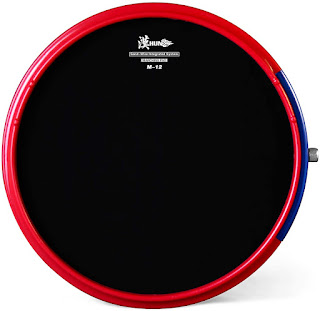In a nutshell -- in case you're new here or haven't been following along -- some very cool modern pad designs are being copied and sold for slightly less by overseas companies. It's highly possible that ALL pads of a similar design (see: RCP Active Snare pad, Salyers Stealth pad, etc) are being made in the same Chinese factory and simply branded according to the job order. That's certainly the case with the aforementioned pads, which share the exact same design with the original made by HUN in China.
But what happens when the design of a particular pad is patented by an American inventor/company and copies show up overseas?
Copyright and patent law is a tricky, weird thing, especially as technology outstrips the law's ability to protect so-called "intellectual" property.
The P4 practice pad, designed by drummer Pat Petrillo, provides another example of when and how patent protection can be unclear, or even ignored.
It's a cool idea. Make a drum pad with multiple levels, laid out like a tiny version of a drum kit, and then create exercises that allow one to transfer drum kit skills from the pad to the drums.
The pad has found an audience and is currently being licensed and sold through Drumeo, with other retail outlets (like Musician's Friend and Amazon) offering it as well.
Another version of the same pad is available through Chinese wholesale giant Alibaba. If you buy it in China it will cost less. If you want it shipped to the USA, that savings is eaten up by the shipping cost.
Here's the thing: The Petrillo pad is made in the USA. The Chinese knockoff is made in China, likely in one of the factories contracted by Alibaba (though that information is nearly impossible for the average citizen to ascertain). If the USA-made original pad costs $60 retail, and the Chinese copy costs nearly the same, why bother go to the trouble?
Simply because the copy can be sold for less in places where the USA pad would perhaps cost more by the time additional tarrifs and taxes are added on.
(Below: the original P4 pad and its copy. Note the difference in platform shape, likely to skirt any patent issues. Also consider the differences in stack height and, without being able to research thoroughly, materials used. It it nearly impossible to research the materials used in manufacturing unless you either buy the pads and test them yourself, or if you know someone directly involved with the process.)


But clearly someone is having those pads shipped overseas, or else Alibaba wouldn't offer the option at their site. In fact, European drum shops are ordering Alibaba's pad in bulk and selling it at their online shops. What you have, in the end, is multiple copies of someone's pad design flying all over the world. Who benefits? How different are the pads in construction, design and usefulness? And why does no one seem to wonder what the point is of copying the design and selling copies all over the place?
Finally, who needs all these drum pads?
While it's great to have choices, how many people are actually buying all these practice pads?
While we attempt to recover from the shakeup of the global marketplace caused in large part by the Covid pandemic, the fact is that even before the lockdown on 2020, drum pads were not a product with planet-wide appeal. So at what point do we say enough is enough? How many different kinds of practice pads does the planet need?
It seems that at some point, a shakeout of the lesser sellers would happen.
But other than the epic flameout of Xymox, I haven't really seen that.
In fact, a lot of older drummers are sticking with pads they've used since adolescence (I still have my Remo pad from 5th grade, and I even pull it out from time to time to use it); or they are trying to find the pad they had in high school and replace it (see the crazy market for tan HQ-Real Feel pads right now).
As I test and report on various practice pads here, it becomes really expensive to buy each pad I'd like to test. Since almost no one has offered to send me models to test, I have to do as much research as I can and fill in the blanks with guesses based on my 20 years of managing inventory for a small retail business. Sometimes I simply can't get all the right answers myself. If I'm lucky, someone with connections to a given design will fill in a blank. If not, all I have left is guessing.
NOTE: When I guess wrong, please let me know by providing useful information. And please try not to scold. I can only work with the information I am able to find, and it's not all forthcoming so easily.
(I appreciate the additional info from someone connected to the original designer, which allowed me to edit portions of this post to reflect more information.)
I ponder these things mostly out of concern for the sustainability of the whole enterprise. How many drummers need how many pads? How can we stop the overproduction of cheap copies? How do we protect someone's design? It feels a lot like the lawless Wild West.
And it's filling the world with cheap copies of stuff we don't really need.
This reality touches every area of interest where things are needed to pursue an activity.
I have no real answers, other than to restrict my future collecting and explorations to used/older drum pads and to think carefully before each purchase.
As with anything we pursue and the stuff we purchase, to support the inventor it's best to buy the inventor's official design, both to support the inventor AND to discourage the manufacture and sale of cheaper knockoffs. This is as true in drum gear as it is in anything else.
Stay tuned. And happy chopping!









